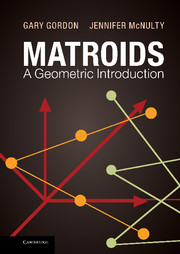Bibliography[1] K., Appel and W., Haken. Every planar map is four colorable. Bull. Amer. Math. Soc., 82: 711–712, 1976.
[2] L., Babai, C., Pomerance and P., Vèrtesi. The mathematics of Paul Erdös. Notices of the AMS, 45(1): 19–31, 1998.
[3] G., Birkhoff. Abstract linear dependence in lattices. Amer. J. Math, 57: 800–804, 1935.
[4] G., Birkhoff. Lattice Theory, third edition, volume XXV. American Mathematical Society, Providence, RI, 1967.
[5] R., Bixby. On Reid's characterization of the ternary matroids. J. Combin. Theory Ser. B, 26: 174–204, 1979.
[6] A., Björner, M., Las Vergnas, B., Sturmfels, N., White and G., Ziegler. Oriented Matroids, Encyclopedia of Mathematics and Its Applications, volume 46. Cambridge, New York, 1993.
[7] A., Bondy and U. S. R., Murty. Graph Theory (Graduate Texts in Mathematics), volume 244. Springer, New York, 2008.
[8] T., Brylawski. A decomposition for combinatorial geometries. Trans. Amer. Math. Soc., 171: 235–282, 1972.
[9] T., Brylawski. Appendix of matroid cryptomorphisms. Encyclopedia Math. Appl. – Theory of Matroids, 26(1): 298–312, 1986.
[10] T., Brylawski and D., Kelly. Matroids and Combinatorial Geometries, Carolina Lecture Series, volume 8. Department of Mathematics, University of North Carolina, Chapel Hill, NC, 1980.
[11] T., Brylawski and J., Oxley. The Tutte polynomial and its applications. Encyclopedia Math. Appl. – Matroid Applications, 40: 123–225, 1992.
[12] H., Crapo. The Tutte polynomial. Aequationes Math., 3: 211–229, 1969.
[13] P., Davis and R., Hersh. The Mathematical Experience. Birkhäuser, Boston, 1981.
[14] J., Geelen, A., Gerards and A., Kapoor. The excluded minors for GF(4)-representable matroids. J. Combin. Theory Ser. B, 79: 247–299, 2000.
[15] R., Graham and P., Hell. On the history of the minimum spanning tree problem. IEEE Ann. Hist. Comput., 7: 43–57, 1985.
[16] R. L., Graham, M., Grötschel and L., Lovász, editors. Handbook of Combinatorics, volume 1. Elsevier, Amsterdam, 1995.
[17] D., Hughes and F., Piper. Projective Planes, Graduate Texts in Mathematics, volume 6. Springer, New York, 1973.
[18] A. W., Ingleton. A note on independence functions and rank. J. London Math. Soc., 34: 4–56, 1959.
[19] D., Kelly and G.-C., Rota. Some problems in combinatorial geometry. Proc. Internat. Sympos., Colorado State Univ., Fort Collins, Colo., 1971, 57: 309–312, 1973.
[20] J., Kruskal. On the shortest spanning tree of a graph and the traveling salesman problem. Proc. Amer. Math. Soc., 7: 48–50, 1956.
[21] C. W. H., Lam, L., Thiel and S., Swiercz. The non-existence of finite projective planers of order 10. Canad. J. Math., XLI: 1117–1123, 1989.
[22] J., Lipton. An Exaltation of Larks. Penguin Books, New York, 1968, 1977, 1991.
[23] S., MacLane. Some interpretations of abstract linear dependence in terms of projective geometry. Amer. J. Math, 58: 236–240, 1936.
[24] C., Merino, A., de Mier and M., Noy. Irreducibility of the Tutte polynomial of a connected matroid. J. Combin. Theory Ser. B, 83: 298–304, 2001.
[25] J., Oxley. What is a matroid?Cubo Math. Educ., 5(3): 179–218, 2003.
[26] J., Oxley. Matroid Theory, second edition. Oxford University Press, New York, 2011.
[27] R., Rado. A theorem on independence relations. Quart. J. Math, 13: 83–89, 1942.
[28] N., Robertson, D., Sanders, P., Seymour and R., Thomas. A new proof of the four-colour theorem. Electron. Res. Announc. Amer. Math. Soc., 2: 17–25, 1996.
[29] G. C., Rota. On the foundations of combinatorial theory 1. Theory of Möbius functions. Z. Wahrscheinlichkeits theorie u. Verw. Gebiete, 2: 340–368, 1964.
[30] W., Schwärzler. Being Hamiltonian is not a Tutte invariant. Discrete Math., 91: 87–89, 1991.
[31] P., Seymour. Matroid representation over GF(3). J. Combin. Theory Ser. B, 26: 159–173, 1979.
[32] R., Stanley. An Introduction to Hyperplane Arrangements, IAS/Park City Mathematical Series, volume 14. American Mathematical Society, Providence, RI, 2004.
[33] R. P., Stanley. Acyclic orientations of graphs. Discrete Math., 5: 17–178, 1973.
[34] F., Stevenson. Projective Planes. Freeman, San Francisco, 1972.
[35] W. T., Tutte. A homotopy theorem for matroids I, II. Trans. Amer. Math. Soc., 88: 144–174, 1958.
[36] J. H., van Lint and R. M., Wilson. A Course in Combinatorics. Cambridge University Press, Cambridge, 1992.
[37] D. J. A., Welsh. Matroid Theory. L. M. S. Monographs, volume 8. Academic Press, London, 1976.
[38] D., West. Introduction to Graph Theory, second edition. Prentice Hall, 2001.
[39] N., White. Theory of Matroids, Encyclopedia of Mathematics and Its Applications, volume 26. Cambridge University Press, New York, 1986.
[40] N., White. Combinatorial Geometries, Encyclopedia of Mathematics and Its Applications, volume 29. Cambridge University Press, New York, 1987.
[41] N., White. Matroid Applications, Encyclopedia of Mathematics and Its Applications, volume 40. Cambridge University Press, New York, 1992.
[42] H., Whitney. On the abstract properties of linear dependence. Amer. J. Math, 57: 509–533, 1935.
[43] T., Zaslavsky. Facing up to Arrangements: Facecount Formulas for Partitions of Space by Hyperplanes, volume 154. American Mathematical Society, 1975.
[44] G., Ziegler. Lectures on Polytopes, Graduate Texts in Mathematics, volume 152. Springer, New York, 1995.





